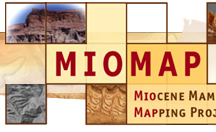BIOCHRONOLOGIC STANDARDS:
Age assignments
were taken from the original publications, then updated to conform to
Tedford et al. (2004) (listed below), based on the trail of information
that could be followed through the literature regarding the stratigraphic
position of specimens. Inasmuch as possible, actual stratigraphic context
was considered in making age assignments. Tedford et al. (2004) provides
the biochronologic scheme and correlation to the radiometric and magnetostratigraphic
time scales that are used in the current version of the MIOMAP archival
database. The reference is:
Tedford, R.
H., L. B. Albright, A. D. Barnosky, I. Ferrusquia-Villafranca, R.
M. Hunt, Jr., J. E. Storer, C. C. Swisher III, M. R. Voorhies, S.
D. Webb, and D. P. Whistler. 2004. Mammalian biochronology of the
Arikareean through Hemphillian interval (Late Oligocene through Early
Pliocene epochs) p.169-231 in M. O. Woodburne (ed. ), Late Cretaceous
and Cenozoic Mammals of North America: Biostratigraphy and Geochronology.
The interim version
of the MIOMAP database that existed from 2000-2003 used a slightly different
standard for correlations between biochronologic, magnetostratigraphic,
and radiometric ages, namely:
Woodburne,
M. O., and C. C. Swisher, III. 1995. Land mammal high-resolution geochronology,
intercontinental overland dispersals, sea level, climate, and vicariance.
SEPM Special Publication 54:335-364.
As of 2004, all
entries were adjusted to conform to Tedford et al. (2004). Prior to
2004, publications based on the then-existing MIOMAP database utilized
the previously accepted standard of Woodburne and Swisher (1995).





